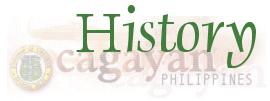
h o m e :: |
The People
Archeologists tell us that the earliest man in the Philippines probably lived in Cagayan thousands of years ago. In their search for this guava man--a likely contemporary of the Java Man--excavators are turning our earth down side up, but unless and until they can convince us with evidence beyond scientific doubt, we cannot point to that guava man as our ancestor or precursor on terra Cagayana. From available evidence, the first man hereabout was the Atta, a short dark-skinned nomad who was at home nowhere and everywhere until the Indo-Malays came to hem him in somewhere, in the jungles where root and fruit helped him survive. Sometime between 200 B.C. and 300 A.D. when mass immigrations into our island group took place, the Indo-Malays who eventually came to be known as Ybanag, Ytawes, Yogad, Gaddang, Yraya, and Malaueg, settled in Cagayan Valley. Though they were known by different handles and labels, they were really one ethnic family, albeit for better or for worse, for richer or for poorer, and for any number and kind of excuses, they opted for a parting ways when they arrived at points where the trails forked our here or there. Evidence of their original oneness are the similarities in their features, the common elements in their languages, beliefs and practices, and the unchanging reference among all of them to the same legendary heroes, Biwag and Malana. These were the people whom the Spaniards found in villages on the sea-coast and along the rivers all over the valley. These villages followed a modus vivendi among themselves described in the anomie of "maguray y maporay, mesipo y masippo, mawawan y karwan." Rightly judging these people to be of single racial stock, the Spaniards decided to make the Ybanag tongue their lingua franca, civilly and ecclesiastically enforced, and they lumped them together under the common denominator "Cagayanes." In later years, the Cagayanes of yesterday became the Cagayanos of today.
from Vignettes About Cagayan and the Cagayanos by Msgr. Domingo Mallo-Peņaflor
guestbook :: forum :: contact :: site map :: site info |
|||||||||||||||||||||||||||||||||||||||||||||||||||||||||||||||||||||||||||||||||||||||||||||||



